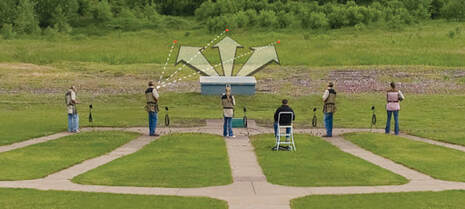|
American trap is popular throughout the United States and may well be the most popular form of clay target shooting in North America. Official events and rules are governed by the Amateur Trapshooting Association or ATA. The ATA is the primary governing body of American trapshooting.
The ATA hosts the Grand American World Trap Shooting Championships, which is held every August at the World Shooting and Recreational Complex in Sparta, Illinois. The Grand attracts as many as 6,000 shooters over the length of the event, which is billed as the world's largest shooting event. The ATA sanctions registered trapshooting competitions at local clubs and facilities throughout North America, and it also coordinates Zone competitions leading up to the Grand American each summer along with "Satellite Grands" throughout the U.S. State organizations also hold state championship shoots each year, which are also coordinated with and sanctioned by the ATA. |
American trap is broken down into three categories: singles, doubles, handicap. The targets are thrown by a machine located at approximately ground level and covered by a "trap house." For singles and doubles, there are five "stations," each 16 yards (15.6 m) behind the trap house. In singles, each competitor shoots at five targets from each station. The trap machine oscillates left to right within a 35 degree arc, and the competitor does not know where in that arc the target will emerge. In doubles, the machine does not oscillate, but throws two targets simultaneously. Each competitor shoots at ten targets from each station. In the handicap event, the machine operates the same as in singles, but the shooters stand further away from the trap house. Adult male shooters start from 20 yards (18.3 m) away; women and sub-juniors start at the 19-yard (17.3 m) line. Each time a competitor wins an event or shoots a score of 96 or higher, s/he earns yardage (also known as "getting a punch"), and must thereafter shoot from further away from the traphouse. The maximum distance at which the handicap event is shot is 27 yards (24.7 m). Safety regulations prohibit members of a handicap squad from shooting at distances more than three yards (2.7 m) apart. In all American trap events, each shooter is allowed only one shot per target.
When shooting American trap for practice or fun a squad of five will shoot 25 targets each for a total of 125. Registered ATA shoots require shooters to shoot 50, 100, or 200 targets per event (depending on the scheduled event). Most of these shoots are for personal average or handicap yardage.
A variant of standard trap is Wobble or Wobble trap. The main differences are a much more extreme target flight path than in standard trap shooting (the trap oscillates up and down as well as side to side), shooters are allowed two shots per pull, and shooters at stations 1 and 5 stand at the 18 yard (16.5 m) mark while positions 2-4 stand at the 17 yard (15.5 m) mark. Although this version of trap is not sanctioned by the ATA, many shooters consider it to be both more challenging and engaging as well as a more realistic preparation for bird hunting. More experienced shooters will often shoot from the Skeet positions to increase the difficulty.
When shooting American trap for practice or fun a squad of five will shoot 25 targets each for a total of 125. Registered ATA shoots require shooters to shoot 50, 100, or 200 targets per event (depending on the scheduled event). Most of these shoots are for personal average or handicap yardage.
A variant of standard trap is Wobble or Wobble trap. The main differences are a much more extreme target flight path than in standard trap shooting (the trap oscillates up and down as well as side to side), shooters are allowed two shots per pull, and shooters at stations 1 and 5 stand at the 18 yard (16.5 m) mark while positions 2-4 stand at the 17 yard (15.5 m) mark. Although this version of trap is not sanctioned by the ATA, many shooters consider it to be both more challenging and engaging as well as a more realistic preparation for bird hunting. More experienced shooters will often shoot from the Skeet positions to increase the difficulty.
ATA Registered Trap Shoot Dates:


